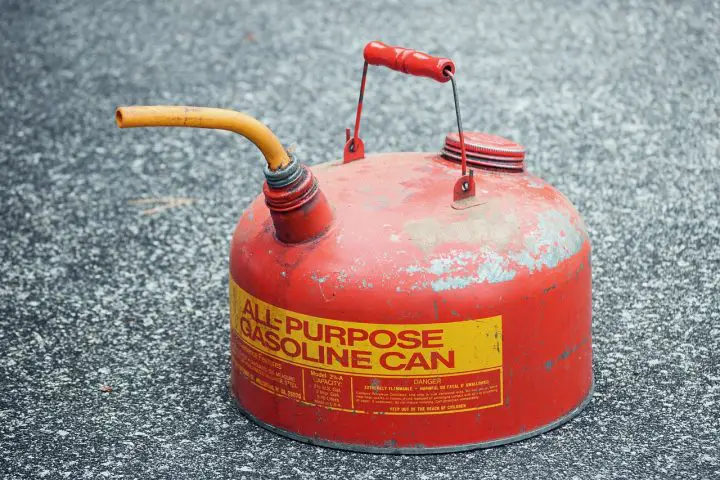Did you recently purchase a chainsaw? Or, are you considering purchasing a chainsaw but unsure about how to properly fuel it? In actuality, the majority of chainsaws are constructed using 2-cycle (or 2-stroke) engines, which need a combination of fuel and oil to function.
Oil is combined with gasoline, or “petrol,” to lubricate the engine’s internal components while it is running. The interior parts of the gasoline tank would freeze up if there was no oil in it. The trick is knowing how to correctly mix the oil and gas mixture.
In this article, we’ll present a step-by-step guide on how to mix chainsaw gas at the correct ratio, along with key considerations to keep in mind.
Table of Contents
- Gasoline to Oil Mixture Ratio Charts
- How to Mix Chainsaw the Correct Gas Mixture
- Important Considerations
- Mixing Chainsaw Gas Do’s and Dont’s
- FAQs (Frequently Asked Questions)

Gasoline to Oil Mixture Ratio Charts
Before getting stuck into the “how-to”, it’s important to understand what specific ratio your chainsaw requires. Each chainsaw engine is made uniquely and needs a particular proportion of gasoline to oil to operate. The most popular gas-oil combinations are 40 to 1 (or 4:1) and 50 to 1 (or 50:1).
To know which one your chainsaw requires, refer to the user’s manual, or search for your chainsaw model online. You can use the charts below to find out how much of each type of fluid to use to get your chainsaw’s gas-to-oil ratio just right.
40:1 Gas Oil Mixture Chart
| Gallons of Gasoline | Fluid Ounces of Oil |
|---|---|
| 1 gal. | 3.2 oz. |
| 2 gal. | 6.4 oz. |
| 3 gal. | 9.6 oz. |
| 4 gal. | 12.8 oz. |
| 5 gal. | 16 oz. |
50:1 Gas Oil Mixture Chart
| Gallons of Gasoline | Fluid Ounces of Oil |
|---|---|
| 1 gal. | 2.6 oz. |
| 2 gal. | 5.12 oz. |
| 3 gal. | 7.68 oz. |
| 4 gal. | 10.24 oz. |
| 5 gal. | 12.8 oz. |
How to Mix Chainsaw the Correct Gas Mixture
Never combine fuels in a small area. Always carry out these actions in a room with good ventilation. Read your product’s instruction manual for more information on how to mix fuel and fuel mixtures before combining oil and gas. To locate the user guide for your chainsaw if you’ve lost it, visit your manufacturer’s website and search for the model.
Ensure that the gasoline bottle you are using is authorized. We advise using a no-spill fuel bottle because it is precisely made to prevent leaks, evaporation, and permeation.
Never choose cheap gasoline when choosing a fuel source. For your blend, mid-grade unleaded gasoline with a minimum octane rating of 89 is advised. Lower octane rating fuel may raise engine temperatures, raising the possibility of piston seizing and engine damage.
How to Mix Chainsaw Gas at the Correct Mixture Step-by-Step Guide
Total Time: 5 minutes
Pour in Gasoline
Open the approved container and pour in half of the gasoline.
Pour in Oil
Pour all the oil required for the 40:1 or 50:1 ratio of your chainsaw.
Shake Container
Close the approved container and shake it vigorously for 10-15 seconds to ensure the gas and oil mix.
Add in Remaining Gas
Open the approved container and add the rest of the gasoline.
Shake Container Again
Close the approved container and shake it vigorously for another 10-15 seconds to ensure the gas and oil mix.
Before Pouring
To prevent dirt from falling into the tank, thoroughly clean the fuel cap and the area around it before filling the tank. Always place the machine with the cap facing up. Carefully unscrew the fuel cap so that any pressure buildup in the tank can gently release to prevent the possibility of fuel coming into direct contact with skin and inhaling fuel vapor.
Pour Mixture into Chainsaw
The gas and oil mixture should fill the chainsaw’s fuel tank to roughly 80% of its capacity once you remove the tank cover. Secure the fuel tank cap, then clean up any spills.
Materials: UL or FM approved container 1 gallon or more of 89 octane or higher ethanol-free gasoline 3-ounce bottle or more of 2-cycle oil
It is advised that you only combine enough fuel for a few days’ worths of labor. Never keep fuel for longer than three months. Before fuelling your machine with fuel that has been sitting around for any length of time, shake the mixture in the canister.
Some folks might be tempted to increase the amount of oil in their correct fuel mixture to better shield their chainsaw gas engine’s internal components from the effects of friction. While this could be beneficial, doing too much can also be harmful. When a 2-stroke engine is run with too much oil, more carbon will accumulate on the pistons.
Important Considerations
Gas Type
The type of gasoline you use in your chainsaw has a huge impact on how long the engine lasts. Never use inexpensive products. And never use ethanol-containing gasoline. Use ethanol-free gasoline with an octane value of at least 89. Lower octane fuel may raise the engine’s temperature, which could harm its internal components.
Oil Type
Gasoline must be blended with a certain kind of oil for 2-cycle chainsaws. Regular motor oil from a car won’t work since it lacks the necessary qualities to lubricate a 2-cycle engine and will reduce the chainsaw’s performance. Therefore, check the oil container to see if it says “two-cycle,” “2-cycle,” “2-stroke,” or “2T.”
Approved Containers
You must combine gasoline and oil for your chainsaw in a fuel storage container that has been given the seal of approval. Gasoline should not be transported or stored in milk jugs, anti-freeze jugs, glass containers, or any other unofficial “gas cans” or containers.
Plastics that have not been approved deteriorate over time and are incompatible with the chemical composition of gasoline. Many of those containers are also not robust enough to sustain the stresses of temperature-related expansion and contraction.
Safety cans that have been authorized by Factory Mutual (FM) or Underwriters Laboratories (UL) are the finest for handling gasoline. Therefore, check to see if the container has one of these permissions stamped on it before combining your chainsaw gas in it.
Mixing Chainsaw Gas Do’s and Dont’s
It is imperative to not mix gasoline and oil in the fuel tank of a chainsaw and to only use containers that are UL or FM approved. The proper ratio of petrol and 2-stroke oil is essential for the chainsaw to run efficiently and avoid damage.
It is important to never refuel a chainsaw while it is still running and to ensure that the chainsaw, as well as your personal clothing, are free of fuel before starting the device.
Smoking should also be avoided during any part of the chainsaw process, including mixing, refueling, and use. It is recommended to only mix enough fuel for the current job, as stale gas can lead to carburetor clogging.
Finally, it is best to either run the chainsaw until the fuel tank is empty or store leftover fuel in an approved container, rather than leaving it in the tank of the chainsaw.
Here are a couple of useful YouTube demonstrations on the topic, including premium Stihl 2-cycle oil:
FAQs (Frequently Asked Questions)
What ratio should I mix my chainsaw gas?
Every chainsaw engine is built differently and requires a specific ratio of gasoline to oil to run. 40 to 1 (4:1) and 50 to 1 (50:1) are the most common gas-oil ratios. Check the user’s manual to find out which ratio your chainsaw needs.
How do you mix 50 to 1 chainsaw fuel?
Prior to adding the 1 gallon of gasoline, put the 2.6 oz of oil to the canister. To verify that the oil and fuel are well blended, close the canister and give it a strong handshake.
How do you mix chainsaw gas?
Pour half of the gasoline into the authorized container after opening it. Pour all the oil required for the 40:1 or 50:1 ratio of your chainsaw. To guarantee that the gas and oil mix, close the permitted container and shake it hard for 10 to 15 seconds. To add the remaining gasoline, preheat the acceptable container. To guarantee that the gas and oil mix, close the authorized container and shake it vigorously for an additional 10 to 15 seconds.
How do you calculate a 50 to 1 ratio?
Use 2.6 fluid ounces of oil per gallon of gas for a 50:1 gas-to-oil ratio.






